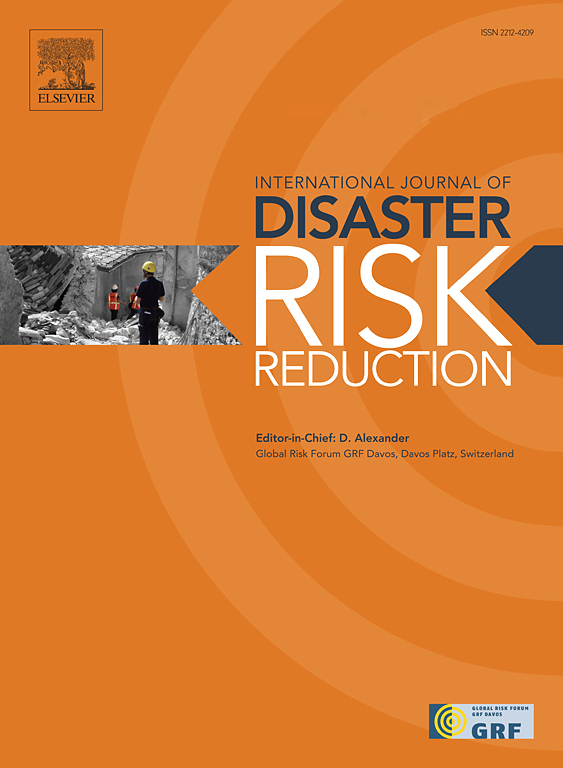Climate change has increased rainfall-induced landslide damages in central China
IF 4.2
1区 地球科学
Q1 GEOSCIENCES, MULTIDISCIPLINARY
International journal of disaster risk reduction
Pub Date : 2025-02-17
DOI:10.1016/j.ijdrr.2025.105320
引用次数: 0
Abstract
Global warming exacerbates the frequency of extreme precipitation events and inevitably increases the risk of hydrogeological disasters such as landslides. Understanding the impact of climatic drivers, particularly precipitation, of landslides and the resulting damages is crucial for effective risk management and mitigation strategies. However, few researchers have turned to quantify the causal effects of precipitation anomalies on landslide damages. This study focuses on Jiangxi Province, China, over the period from 2011 to 2020, aiming to quantify the contribution of historical climate change to landslide damages using a panel regression framework with fixed effects. We quantify the impact of long-term and short-term precipitation on landslide damages considering geographical and seasonal differences based on satellite rainfall products. Our results show positive and significant effects of both long-term and short-term precipitation on landslide damages, with a unit anomaly increase corresponding to a 99.7 % increase in damages. Considering the income equality, landslide damages in rich counties show greater sensitivity to monthly precipitation anomaly compared to poor counties. Moreover, we find that climate change contributed to 32.8 % of the total landslide damages in Jiangxi Province over the past decade, amounting to 57 million CNY. Overall, we believe this work could provide quantitative information about the economic costs of climate change on landslides and facilitate related adaptation and resilience strategies.
全球变暖加剧了极端降水事件的发生频率,不可避免地增加了山体滑坡等水文地质灾害的风险。了解气候驱动因素(尤其是降水)对山体滑坡及其造成的损失的影响,对于有效的风险管理和减灾战略至关重要。然而,很少有研究人员转而量化降水异常对滑坡灾害的因果影响。本研究以中国江西省为研究对象,研究时间跨度为 2011 年至 2020 年,旨在利用固定效应的面板回归框架量化历史气候变化对滑坡损失的影响。我们基于卫星降水产品,考虑地理和季节差异,量化了长期和短期降水对滑坡损失的影响。我们的研究结果表明,长期和短期降水对滑坡损失都有积极而显著的影响,单位异常值的增加相当于损失的 99.7%。考虑到收入平等,富裕县的滑坡损失对月降水异常的敏感性高于贫困县。此外,我们还发现,在过去十年中,气候变化造成的损失占江西省滑坡总损失的 32.8%,达 5700 万人民币。总之,我们相信这项工作可以提供气候变化对滑坡造成的经济损失的定量信息,并促进相关的适应和抗灾战略。
本文章由计算机程序翻译,如有差异,请以英文原文为准。
求助全文
约1分钟内获得全文
求助全文
来源期刊

International journal of disaster risk reduction
GEOSCIENCES, MULTIDISCIPLINARYMETEOROLOGY-METEOROLOGY & ATMOSPHERIC SCIENCES
CiteScore
8.70
自引率
18.00%
发文量
688
审稿时长
79 days
期刊介绍:
The International Journal of Disaster Risk Reduction (IJDRR) is the journal for researchers, policymakers and practitioners across diverse disciplines: earth sciences and their implications; environmental sciences; engineering; urban studies; geography; and the social sciences. IJDRR publishes fundamental and applied research, critical reviews, policy papers and case studies with a particular focus on multi-disciplinary research that aims to reduce the impact of natural, technological, social and intentional disasters. IJDRR stimulates exchange of ideas and knowledge transfer on disaster research, mitigation, adaptation, prevention and risk reduction at all geographical scales: local, national and international.
Key topics:-
-multifaceted disaster and cascading disasters
-the development of disaster risk reduction strategies and techniques
-discussion and development of effective warning and educational systems for risk management at all levels
-disasters associated with climate change
-vulnerability analysis and vulnerability trends
-emerging risks
-resilience against disasters.
The journal particularly encourages papers that approach risk from a multi-disciplinary perspective.
 求助内容:
求助内容: 应助结果提醒方式:
应助结果提醒方式:


